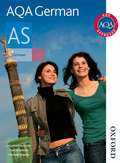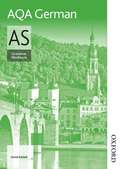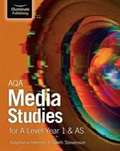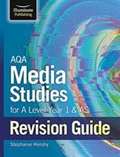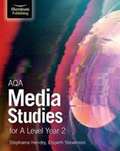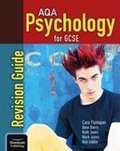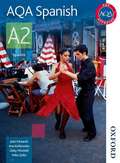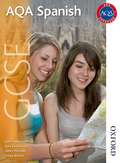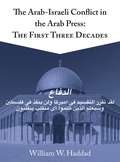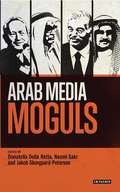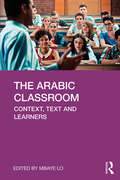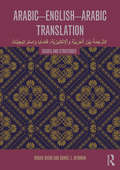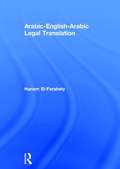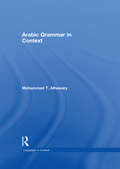- Table View
- List View
AQA German AS: Student Book (PDF)
by Michael Wardle Paul Shannon Monika NiedzielaAQA German is the only set of resources to have been developed with, and exclusively endorsed by AQA, making them the first choice to support AQA's 2008/2009 specifications for AS and A2. With a range of truly blended resources, AQA German offers complete coverage and support through a variety of printed and online media.
AQA German AS Grammar Workbook (PDF)
by David RiddellNew to accompany our AQA AS German course, these workbooks provide detailed, step-by-step grammar support for independent work. Varied activities track Student Book grammar coverage, while transition and exam-style practice sections provide further reinforcement. Separate book is available for A2.
AQA Media Studies for A Level Year 1 & AS: Student Book (PDF)
by Stephanie Hendry Elspeth StevensonEndorsed by AQA and created especially for the new AQA Media Studies A Level and Year 1 and AS specifications being taught from September 2017, this student book offers high quality support you can trust. // Written by experienced Media Studies teachers and examiners. // Knowledge, understanding and skills are developed through the textbook and presented in a highly accessible way. // Includes practical approaches to developing skills, and contemporary case studies of media industries throughout. // The Non-Examined Assessment is supported with a chapter containing clear, student-focused guidance on meeting requirements. // Contains practical suggestions for effective ways to deliver the subject content. // Exam practice and skills guidance are provided, introducing students to the assessment criteria and mark schemes. // Designed for students of all ability levels with extension questions and tasks to stretch and challenge the most able learners.
AQA Media Studies for A Level Year 1 & AS Revision Guide (PDF)
by Stephanie HendryDesigned to complement the AQA Media Studies for A Level Year 1 and AS Student Book, this practical and concise Revision Guide supports students preparing for their AQA AS Media Studies assessment. / Written by an experienced Media Studies teacher and senior examiner and presented in a clear and straightforward way making it accessible and easy to use. / Contains just the right amount of detail students need to recap and revise the key content from the course. / Provides examples of detailed analysis across the nine media forms using the theoretical framework and a selection of both the targeted and in-depth CSPs. / Offers advice and guidance on approaching the various types of questions students may encounter in the exam.
AQA Media Studies for A Level Year 2 (PDF) (400MB+)
by Stephanie Hendry Elspeth StevensonPlease request 400MB+ by WeTransfer. Created especially for the new AQA Media Studies A Level Year 2 specifications being taught from September 2017, and written by experienced Media Studies teachers and examiners, this new student book offers high quality support you can trust. / Knowledge, understanding and skills are developed through the textbook and presented in a highly accessible way. / Includes practical approaches to developing skills, and contemporary case studies of media industries throughout. / The Non-Examined Assessment is supported with a chapter containing clear, student-focused guidance. / Contains practical suggestions for effective ways to deliver the subject content. / Designed for students of all ability levels with extension questions and tasks to stretch and challenge the most able learners. / This student book has entered AQA's official endorsement process.
AQA Psychology for GCSE: Revision Guide (PDF)
by Cara Flanagan Ruth Jones Mark Jones Rob LiddleWritten by Cara Flanagan and a highly experienced author team, this Revision Guide provides everything students need to know for their exams. // All the essential content for one topic - description and evaluation on one spread. // Invaluable exam tips. // `Apply it' questions allow students to apply their knowledge to a scenario question - some 'Apply it' questions focus on research methods. // `Knowledge check' questions are typical exam-style questions for that topic. // Suggested answers for 'Apply it' and 'Knowledge check' questions are provided as a free downloadable file. // Activities on every topic to improve exam skills and performance. // Two `write-in' activities on each topic help students practise and process the information on that topic. // All the activities are designed to help students correctly interpret and answer the exam questions. // Suggested answers for all the activities are provided as a free downloadable file.
AQA Spanish A2: Student Book (PDF)
by Kolkowska Ana Mitchell Libby Edwards Jean Zollo MikeAQA Spanish is the only set of resources to have been developed with, and exclusively endorsed by AQA, making them the first choice to support AQA's 2008/2009 specifications for AS and A2. With a range of truly blended resources, AQA Spanish offers complete coverage and support through a variety of printed and online media.
AQA Spanish AS: Student Book (PDF)
by Edwards Jean Kolkowska Ana Mitchell Libby Zollo MikeThis book has been planned and written alongside the AQA Spanish ASnbsp;specifi cation by a team of senior examiners and teachers.
AQA Spanish GCSE: Student Book (PDF)
by Halksworth John Kolkowska Ana Mitchell Libby Wilson FionaYour cost-effective online language lab, accessible anywhere, anytime AQA GCSE Spanish is the only resource to have been developed with and exclusively endorsed by AQA. With a real focus on tracking individual progress, you can improve your students' chance of exam success through a unique blend of print and electronic resources.
The Arab Business Code
by Judith HornokThe Gulf Cooperation Council (GCC) countries are some of the richest and most dynamic emerging markets in the world. But they are tough markets! International companies must think seriously if they want to do business there – the barriers can be numerous and difficult. But the opportunities are phenomenal and rewarding. The key to success is to plan and take the right steps. This book shows how to do this by decoding, using case studies, and suggesting relevant solutions. For Judith Hornok, it’s not about dry theories or mind games. Instead this book is based on numerous case studies drawn from the lives of well-known Arab and international business people. The reader can grasp the opportunities and avoid the pitfalls by knowing and understanding the Arab Business Code (ABC): "learning the A-B-Cs." This book offers a study with practical measures, a toolkit of easy-to-learn and simple-to-use techniques that pave the way for business success in the Gulf. Over fifteen years of research is boiled down into a clearly structured, compact book. Judith Hornok presents the insights of her studies by decoding the behavior of Arab business people in the Gulf using innovative techniques and new approaches, which can be easily implemented by the reader. For the first time Judith also presents her creations – the figures of The Seven Emotional Hinderers.
The Arab Business Code
by Judith HornokThe Gulf Cooperation Council (GCC) countries are some of the richest and most dynamic emerging markets in the world. But they are tough markets! International companies must think seriously if they want to do business there – the barriers can be numerous and difficult. But the opportunities are phenomenal and rewarding. The key to success is to plan and take the right steps. This book shows how to do this by decoding, using case studies, and suggesting relevant solutions. For Judith Hornok, it’s not about dry theories or mind games. Instead this book is based on numerous case studies drawn from the lives of well-known Arab and international business people. The reader can grasp the opportunities and avoid the pitfalls by knowing and understanding the Arab Business Code (ABC): "learning the A-B-Cs." This book offers a study with practical measures, a toolkit of easy-to-learn and simple-to-use techniques that pave the way for business success in the Gulf. Over fifteen years of research is boiled down into a clearly structured, compact book. Judith Hornok presents the insights of her studies by decoding the behavior of Arab business people in the Gulf using innovative techniques and new approaches, which can be easily implemented by the reader. For the first time Judith also presents her creations – the figures of The Seven Emotional Hinderers.
Arab Digital Journalism (Disruptions)
by Noha MellorResponding to urgent calls to de-westernise Media and Journalism Studies and shed light on local agency, this book examines digital journalistic practices in the Arab region, exploring how Arab journalists understand their roles and how digital technologies in Arab newsrooms are used to influence public opinion. Drawing on tens of articles penned by Arab media professionals and scholars, supplemented with informal conversations with journalists, this book reviews the historical development of digital journalism in the region and individual journalists’ perceptions of this development. While technology has provided a new platform for citizens and powerful agents to exchange views, this text examines how it has simultaneously allowed Arab states and authorities to conduct surveillance on journalists, curtail the rise of citizen journalism, and maintain offline hierarchal forms of political, economic, and cultural powers. Mellor also explores how digital technology serves to cement Western hegemony of the information world order, with Arab media organisations and audiences judged to be mere recipients, rather than producers, of such information. Arab Digital Journalism offers an important contribution to the emerging field of digital journalism in the Global South and is a valuable resource for students and researchers interested in media, journalism, communication, and development studies.
Arab Digital Journalism (Disruptions)
by Noha MellorResponding to urgent calls to de-westernise Media and Journalism Studies and shed light on local agency, this book examines digital journalistic practices in the Arab region, exploring how Arab journalists understand their roles and how digital technologies in Arab newsrooms are used to influence public opinion. Drawing on tens of articles penned by Arab media professionals and scholars, supplemented with informal conversations with journalists, this book reviews the historical development of digital journalism in the region and individual journalists’ perceptions of this development. While technology has provided a new platform for citizens and powerful agents to exchange views, this text examines how it has simultaneously allowed Arab states and authorities to conduct surveillance on journalists, curtail the rise of citizen journalism, and maintain offline hierarchal forms of political, economic, and cultural powers. Mellor also explores how digital technology serves to cement Western hegemony of the information world order, with Arab media organisations and audiences judged to be mere recipients, rather than producers, of such information. Arab Digital Journalism offers an important contribution to the emerging field of digital journalism in the Global South and is a valuable resource for students and researchers interested in media, journalism, communication, and development studies.
Arab-Iranian Rivalry in the Persian Gulf: Territorial Disputes and the Balance of Power in the Middle East (Library Of International Relations Ser.)
by Farzad Cyrus Sharifi-YazdiIranian ambitions in the Persian Gulf and rivalries with Arab neighbours are subject to intense - and heated - speculation, controversy and debate. Here, Farzad Cyrus Sharifi scrutinises the rival Arab-Iranian claims to Bahrain, the Shatt al-Arab waterway, and the Abu Musa and Tunbs islands in the years after World War II and before the Iranian revolution. Through investigation of previously unexamined primary materials and interviews with leading players, this book sheds new light on the evolution and dynamics of hegemonic and nationalistic Arab-Iranian rivalries and how these rivalries began to find symbolic expression through territorial disputes. Sharifi illustrates that these ongoing disputes - and the deep-seated tensions still prevalent in Arab-Iranian relations - are largely rooted in how they were constructed in the post-World War II period, making this book vital reading for researchers of the politics, history, international relations and diplomacy of the Middle East.
The Arab-israeli Conflict In The Arab Press: The First Three Decades (PDF)
by William W. HaddadThis monograph provides a much-needed history of the Arab print media as well as an in-depth study of translated Arab media sources, remedying a remarkable gap in Western intellectual culture. Setting the scene, the manuscript begins with a brief historical narrative of Arab newspapers from the 1940s to the mid-1970s, when a free press virtually disappeared. William Haddad then explores the historiography of the Arab print media, compiling a valuable collection of available scholarship on the subject. The book simultaneously considers the contemporary ongoing problem of censorship in Middle East journalism. With this valuable context, Haddad then sets about examining the Arab print media's view of the Arab-Israeli conflict in its first three decades. By giving voice to the Arab political journalists who wrote editorials and opinion pieces, the bulk of the book explores the variety of opinions held in the Arab print media regarding the Arab-Israeli conflict.
The Arab-Israeli Conflict in the Media: Producing Shared Memory and National Identity in the Global Television Era
by Tamar AshuriThe television industry has metamorphosised from a national and largely-monopolized sector to a commercial and global enterprise. This has profoundly altered the way 'historical truth' and shared memory are constructed and conveyed. Here Ashuri provides a groundbreaking study of the changes through the vantage point of an illuminating mode of television production, international co-productions. By taking an example based on current events in the Middle East - a television documentary on the Arab Israeli conflict co-produced by three television networks (BBC, PBS, MBC) - her study enriches contemporary media research, providing an unprecedented, behind-the-scenes look at the entire production process of a co-produced television history.She shows that making the documentary on the Arab-Israeli struggle turned into a war: a war over competing memories, interpretation, editing, and finally narration. Ashuri's analysis of transnational documentary collaborations reveals inherent tensions between economic constraints and cultural forces, between the local and global, and between 'shared' and 'cosmopolitan' memory.Enriching political economy studies of media by exploring the cultural negotiations at the heart of television production process, and highlighting the economic processes that underlie the contested constructions of national histories, "The Arab-Israeli Conflict in the Media" will be essential reading for those interested in media and television studies, as well as globalization and cultural identity.
Arab Media Moguls: Community, Legitimacy And Public Life
by Naomi Sakr Jakob Skovgaard-Petersen Donatella Della RattaTransformations in the Arab media landscape are a key element in regional dynamics of political change. Where do private owners of Arab media outlets stand on the scene? What part, if any, have they played in weakening dictatorships, countering sectarianism and political polarisation, and reforming business practices in the Arab world? Arab Media Moguls charts the fortunes of some leading media investors and entrepreneurs from Egypt, Lebanon, Saudi Arabia and Tunisia to examine their motives, management styles, financial performance and links to political power. The resulting profiles offer intriguing insights into the place of family, education, religion and media regulation in regional power structures.Globally, the rise of small digital media, increased competition law and the precedence of more digitally-savvy younger generations have fuelled doubts as to whether the archetypal 'media mogul' is a phenomenon with a future. How do such factors affect power plays in Arab media? Responding critically to existing Western scholarship and commentary on magnates in US and European media, this book explores how far existing assumptions and perceptions about powerful media owners' eccentricity, innovation and risk-taking apply in the Arab context and offers a range of alternative approaches to understanding the central position of certain individuals in the fast-changing Arab media business.
Arab Media Systems (Global Communications #3)
by Carola Richter and Claudia KozmanThis volume provides a comparative analysis of media systems in the Arab world, based on criteria informed by the historical, political, social, and economic factors influencing a country’s media. Reaching beyond classical western media system typologies, 'Arab Media Systems' brings together contributions from experts in the field of media in the Middle East and North Africa (MENA) to provide valuable insights into the heterogeneity of this region’s media systems. It focuses on trends in government stances towards media, media ownership models, technological innovation, and the role of transnational mobility in shaping media structure and practices. Each chapter in the volume traces a specific country’s media – from Lebanon to Morocco – and assesses its media system in terms of historical roots, political and legal frameworks, media economy and ownership patterns, technology and infrastructure, and social factors (including diversity and equality in gender, age, ethnicities, religions, and languages). This book is a welcome contribution to the field of media studies, constituting the only edited collection in recent years to provide a comprehensive and systematic overview of Arab media systems. As such, it will be of great use to students and scholars in media, journalism and communication studies, as well as political scientists, sociologists, and anthropologists with an interest in the MENA region. This volume provides a comparative analysis of media systems in the Arab world, based on criteria informed by the historical, political, social, and economic factors influencing a country’s media. Reaching beyond classical western media system typologies, Arab Media Systems brings together contributions from experts in the field of media in the Middle East and North Africa (MENA) to provide valuable insights into the heterogeneity of this region’s media systems. It focuses on trends in government stances towards media, media ownership models, technological innovation, and the role of transnational mobility in shaping media structure and practices. Each chapter in the volume traces a specific country’s media – from Lebanon to Morocco – and assesses its media system in terms of historical roots, political and legal frameworks, media economy and ownership patterns, technology and infrastructure, and social factors (including diversity and equality in gender, age, ethnicities, religions, and languages). This book is a welcome contribution to the field of media studies, constituting the only edited collection in recent years to provide a comprehensive and systematic overview of Arab media systems. As such, it will be of great use to students and scholars in media, journalism and communication studies, as well as political scientists, sociologists, and anthropologists with an interest in the MENA region. This volume provides a comparative analysis of media systems in the Arab world, based on criteria informed by the historical, political, social, and economic factors influencing a country’s media. Reaching beyond classical western media system typologies, Arab Media Systems brings together contributions from experts in the field of media in the Middle East and North Africa (MENA) to provide valuable insights into the heterogeneity of this region’s media systems. It focuses on trends in government stances towards media, media ownership models, technological innovation, and the role of transnational mobility in shaping media structure and practices. Each chapter in the volume traces a specific country’s media – from Lebanon to Morocco – and assesses its media system in terms of historical roots, political and legal frameworks, media economy and ownership patterns, technology and infrastructure, and social factors (including diversity and equality in gender, age, ethnicities, religions, and languages). This book is a welcome contribution to the field of media studies, constituting the only edited collection in recent years to provide a comprehensive and systematic overview of Arab media systems. As such, it
The Arabic Classroom: Context, Text and Learners
by Mbaye LoThe Arabic Classroom is a multicontributor work for trainee and in-service teachers of Arabic as a foreign language. Collected here is recent scholarly work, and also critical writing from Arabic instructors, Arabists and language experts, to examine the status of the teaching and learning of Arabic in the modern classroom. The book stresses the inseparability of the parameters of contexts, texts and learners in the effective Arabic classroom and investigates their role in enhancing the experience of teaching and learning Arabic. The book also provides a regional perspective through global case studies and encourages Arabic experts to search for better models of instruction and best practices beyond the American experience.
Arabic-English-Arabic-English Translation: Issues and Strategies
by Ronak Husni Daniel L. NewmanArabic-English-Arabic-English Translation: Issues and Strategies is an accessible coursebook for students and practitioners of Arabic-English-Arabic translation. Focusing on the key issues and topics affecting the field, it offers informed guidance on the most effective methods to deal with such problems, enabling users to develop deeper insights and enhance their translation skills. Key features include: A focus on Arabic-English translation in both directions, preparing students for the real-life experiences of practitioners in the field In-depth discussion of the core issues of phraseology, language variation and translation, legal translation and translation technology in Arabic and English translation Authentic sample texts in each chapter, taken from a variety of sources from across the Arabic-speaking world to provide snapshots of real-life language use Source texts followed by examples of possible translation strategies, with extensive commentaries, to showcase the best translation practices and methodologies A range of supporting exercises to enable students to practise their newly acquired knowledge and skills Inclusion of a wide range of themes covering both linguistic and genre issues, offering multidimensional perspectives and depth and breadth in learning List of recommended readings and resources for each of the topics under discussion Comprehensive glossary and bibliography at the back of the book. Lucid and practical in its approach, Arabic-English-Arabic-English Translation: Issues and Strategies will be an indispensable resource for intermediate to advanced students of Arabic. It will also be of great interest to professional translators working in Arabic-English-Arabic translation.
Arabic-English-Arabic-English Translation: Issues and Strategies
by Ronak Husni Daniel L. NewmanArabic-English-Arabic-English Translation: Issues and Strategies is an accessible coursebook for students and practitioners of Arabic-English-Arabic translation. Focusing on the key issues and topics affecting the field, it offers informed guidance on the most effective methods to deal with such problems, enabling users to develop deeper insights and enhance their translation skills. Key features include: A focus on Arabic-English translation in both directions, preparing students for the real-life experiences of practitioners in the field In-depth discussion of the core issues of phraseology, language variation and translation, legal translation and translation technology in Arabic and English translation Authentic sample texts in each chapter, taken from a variety of sources from across the Arabic-speaking world to provide snapshots of real-life language use Source texts followed by examples of possible translation strategies, with extensive commentaries, to showcase the best translation practices and methodologies A range of supporting exercises to enable students to practise their newly acquired knowledge and skills Inclusion of a wide range of themes covering both linguistic and genre issues, offering multidimensional perspectives and depth and breadth in learning List of recommended readings and resources for each of the topics under discussion Comprehensive glossary and bibliography at the back of the book. Lucid and practical in its approach, Arabic-English-Arabic-English Translation: Issues and Strategies will be an indispensable resource for intermediate to advanced students of Arabic. It will also be of great interest to professional translators working in Arabic-English-Arabic translation.
Arabic-English-Arabic Legal Translation (PDF)
by Hanem El-FarahatyArabic-English-Arabic Legal Translation provides a groundbreaking investigation of the issues found in legal translation between Arabic and English. Drawing on a contrastive-comparative approach, it analyses parallel authentic legal documents in both Arabic and English to examine the features of legal discourse in both languages and uncover the different translation techniques used. In so doing, it addresses the following questions: What are the features of English and Arabic legal texts? What are the similarities and differences of English and Arabic legal texts? What are the difficult areas of legal translation between English and Arabic legal texts? What are the techniques for translating these difficult areas on the lexical and syntactic levels? Features include: A thorough description of the features of legal translation in both English and Arabic, drawing on empirical new research, corpus data analysis and strategic two-way comparisons between source texts and target texts Coverage of a broad range of topics including an outline of the chosen framework for data analysis, a historical survey of legal discourse developments in both Arabic and English and detailed analyses of legal literature at both the lexical and syntactic levels Attention to common areas of difficulty such as Shariah Law terms, archaic terms and model auxiliaries Many examples and excerpts from a wide selection of authentic legal documents, reinforced by practical discussion points, exercises and practice drills to encourage active engagement with the material and opportunities for hands-on learning. Wide-ranging, scholarly and thought-provoking, this will be a valuable resource for advanced undergraduates and postgraduates on Arabic, Translation Studies and Comparative Linguistics courses. It will also be essential reading for translation professionals and researchers working in the field.
Arabic Grammar in Context (Languages in Context)
by Mohammad AlhawaryArabic Grammar in Context offers a unique and exciting approach to learning grammar. It presents grammar as a necessary and essential tool for understanding Arabic and for developing comprehension and production skills. Features include: authentic texts from a rich variety of sources, literary and non-literary, used as the starting point for the illustration and explanation of key areas of Arabic grammar clear and authoritative demonstration of the relevance of grammar for understanding and interpreting Arabic a wide range of appropriate exercises designed to consolidate learning fully vocalized exercises and texts a glossary of vocabulary and expressions provided at the end of the book audio readings of the texts available online for additional listening practice. Suitable for class use and independent study, Arabic Grammar in Context is ideal for intermediate to advanced learners of Arabic.
Arabic L2 Interlanguage: Syntactic sequences, agreement and variation (Topics in Arabic Applied Linguistics)
by Ghassan HusseinaliArabic L2 Interlanguage is a significant and timely addition to the field of Second Language Acquisition, providing valuable insight into the development of ‘interlanguage’, the interim language of early beginners, in learners of Arabic. This book: Clearly establishes what interlanguage is and why it should form an important part of foreign language teaching Presents the reader with a sequence in which six English-speaking learners of Arabic acquire the language Makes use of the rich morphological and syntactic property of Arabic to offer a new perspective on the field of Second Language Acquisition. Arabic L2 Interlanguage contributes directly towards building a more comprehensive theoretical framework for explaining how L2s are acquired. It will be key text for SLA scholars as well as an important resource for graduate students in Linguistics and Foreign Language Teaching.
Arabic L2 Interlanguage: Syntactic sequences, agreement and variation (Topics in Arabic Applied Linguistics)
by Ghassan HusseinaliArabic L2 Interlanguage is a significant and timely addition to the field of Second Language Acquisition, providing valuable insight into the development of ‘interlanguage’, the interim language of early beginners, in learners of Arabic. This book: Clearly establishes what interlanguage is and why it should form an important part of foreign language teaching Presents the reader with a sequence in which six English-speaking learners of Arabic acquire the language Makes use of the rich morphological and syntactic property of Arabic to offer a new perspective on the field of Second Language Acquisition. Arabic L2 Interlanguage contributes directly towards building a more comprehensive theoretical framework for explaining how L2s are acquired. It will be key text for SLA scholars as well as an important resource for graduate students in Linguistics and Foreign Language Teaching.
